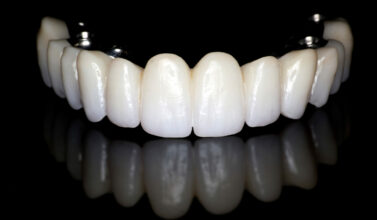Bone Graft for Dental Implants – Is It Really Needed?
Dental implants have revolutionised the field of dentistry in dental surgery and offer a long-term solution for replacing missing teeth. They provide stability, functionality, and an aesthetically pleasing appearance.
However, not everyone who requires a dental implant has enough bone in their jaw to support the dental implant securely. This is where bone grafting treatment may be necessary.
Understanding Bone Graft Material
What is a dental bone graft? Bone grafting is a surgical procedure that involves adding or augmenting bone tissue. Increasing bone density and volume helps create a stable foundation for dental implant fixtures.
During the graft procedure, a small piece of bone is taken from another area of the body (autograft) or sourced from a donor (allograft or xenograft) and transplanted to the deficient area in your jaw. It is also common for synthetic materials to be used as either bone grafts or substitutes.
Why Might You Need A Dental Bone Graft?
- Insufficient Bone Volume: When a tooth is lost or extracted, the surrounding bone in that area may deteriorate due to lack of stimulation. Inadequate bone volume can occur due to gum disease, trauma, or long-term tooth loss. Without adequate bone support (or bone graft in mouth), a dental implant may not be able to integrate properly with the jawbone.
- Sinus Expansion: Upper back teeth are near the sinus cavity. If these teeth are lost or removed, the sinus cavity may expand, encroaching upon the available bone space for implant placement. A sinus lift procedure, often combined with a bone graft, can help create adequate bone height for successful implant placement.
Benefits Of Bone Grafting For Dental Implants
- Enhanced Implant Stability: A bonegraft helps create a solid and secure foundation for the dental implant. It promotes osseointegration, which is the process of the implant fusing with the jawbone. This integration ensures stability, preventing implant movement and potential failure.
- Improved Aesthetics: Insufficient bone volume can lead to an unattractive smile with sunken or collapsed facial features. Grafting can help restore facial structure and provide the necessary support for natural-looking dental restorations, resulting in an aesthetically pleasing smile.
- Long-term Implant Success: A successful graft procedure significantly increases the chances of long-term implant success. The dental implant can withstand the forces of chewing and function like a natural tooth by ensuring proper bone integration and stability. This promotes overall oral health and prevents further bone loss.
- Versatile Treatment Options: Bone grafting opens up opportunities for individuals previously deemed ineligible for dental implants due to inadequate bone. With successful grafting, patients with compromised bone can still benefit from the advantages of dental implant treatment.
While the need for a bone graft before a dental implant may seem like an additional step in the treatment and healing process, it plays a crucial role in ensuring the long-term success of the implant. Bone grafting provides a solid foundation for the implant and enhances aesthetics. Grafting for dentures is not required.
The decision to undergo a dental bone graft should be made in consultation with a qualified dental professional who can assess your situation and recommend the best treatment plan. Remember, each case is unique, and a thorough examination is necessary to determine the need for a dental bone graft.
How Painful Is A Bone Graft?
During the procedure, oral or IV sedation may be utilised for patient comfort, and a local anaesthetic will be administered. Any post-operative discomfort can be managed with appropriate pain relief medication.
How Long Does It Take For A Bone Graft To Heal?
The healing times for bone graft gums depend on the amount of bone grafting or osseous graft required. You should be able to resume usual activities within 3 to 4 days. Grafts can take three to six months to heal. You are advised not to engage in extreme activity during the first six months.
Avoiding Bone Grafting – Zygomatic Implants
If you would like to avoid the time, cost, and healing period of a graft, you may like to consider zygomatic implants.
Zygomatic implants are used when there is insufficient bone in the upper jaw to support conventional implant placement. Zygomatic implants cannot be used in the lower jaw. The procedure involves anchoring the implant into the zygomatic bone (cheekbone), which provides a more secure foundation.
Zygomatic implants are significantly longer than a traditional dental implant (but the implant is longer) and can only be surgically placed by an appropriately trained dental specialist,
Zygomatic implants are a viable solution for people with severe bone loss in the upper jawbone, and as such, they can avoid having grafting. Zygomatic implants are anchored into the cheekbone, which is denser and stronger than the jawbone, allowing for greater stability and support for dental implants. For more information, visit our Zygomatic Implants page.




